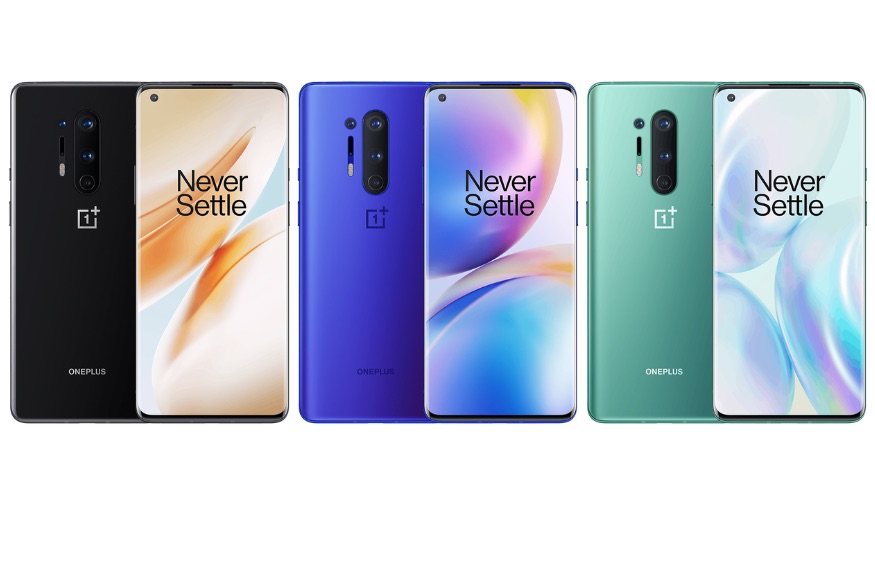The much-awaited OnePlus 8 Pro has been officially announced. The OnePlus 8 Pro comes in two variants, with the 8GB+128GB priced at $899 (~Rs 68,300), and the 12GB+256GB variant priced at $999 (~Rs 75,900).
Officially, this makes it the most expensive OnePlus smartphones so far. The devices will be available for open sale from April 21 in Europe, and April 29 in USA. Exact prices and availability for the devices in India are yet to be announced.
There had been considerable excitement about the OnePlus 8 and the OnePlus 8 Pro as successors to last year’s OnePlus 7 series and the OnePlus 7T series. Let us take a look at the headline specs first, for the OnePlus 8 Pro.
Under the hood is the Qualcomm Snapdragon 865 processor, up to 12GB of RAM, up to 256GB of storage, a quad camera setup taking care of the photography duties, 5G capabilities depending on which part of the world you live in as well as a large 4510mAh battery. You will be able to buy the OnePlus 8 Pro in Onyx Black, Glacial Green and Ultramarine Blue colorways.
This is also the first OnePlus phone which offers wireless charging. And it isn’t just for the sake of ticking off the spec sheet—OnePlus calls this the Warp Charge 30 Wireless, which charges a fully discharged OnePlus 8 Pro’s battery to 50% charge in 30 minutes.
And of course, if you are using the 30-watt wall charger, the 0-50% charge happens in 23 minutes. For a massive 4,510mAh battery, that is actually a great stat to show off. And returning back to the point of wireless charging, the OnePlus 8 Pro also has the Reverse Wireless Charging feature, which lets you also charge other wireless charging capable products (such as phones and earbuds) by simply placing them flat on the back of the OnePlus 8 Pro.
Apart from the latest Qualcomm Snapdragon 865 processor, OnePlus is also using the LPDDR5 RAM modules, which are 30% faster than before and also consume up to 20% lesser power—all this means even faster performance with lesser battery usage.
The 6.78-inch Fluid AMOLED display has the 3168 x 1440-pixel resolution and the 19.8:9 aspect ratio. This also gets the 120Hz refresh rate, which means the display refreshes 120 times per second. Simply put, this means anything has to do with any sort of motion on the screen, will look smoother and silkier. OnePlus has also tweaked the animations in the Oxygen OS to take better advantage of these fine new capabilities.
In fact, the OnePlus 8 Pro also gets the MEMC chip, often found in large screen TVs, which alter the frame rates in videos to upgrade, let’s say a 30fps video to a 120fps video, so that it looks better on this more fluid display. This display is HDR10+ compatible.
OnePlus claims that the OnePlus 8 Pro’s 10-bit colour display produces more than a billion unique colours, which they say is 60X more than standard smartphone displays. This is also expected to be a very bright display, touching as much as 1,300nits of brightness outdoors.
A lot of work has definitely gone into potentially improving the photography performance. There is a 48-megapixel main camera, there is a 48-megapixel ultra-wide camera, an 8-megapixel telephoto camera and a 5-megapixel colour filter camera.
There is 3x hybrid zoom and the main Sony IMX689 sensor as well as the telephoto camera have optical image stabilization as well. What is new is the colour filter camera, which should allow you to add more lighting effects and colour filters to your photos—though how that works, we will only really know when we get to use the OnePlus 8 Pro. The Single Frame 3-HDR technology will surely be very relevant for high contrast photos that have a backlighting scenario.
This also supports the Wi-Fi 6 standard which offers maximum speeds of 9.8Gbps, and that is up to 2.7 times faster than the current Wi-Fi 5 standard.
Those who are lucky enough to get their hands on a OnePlus 8 5G variant will get the choice between Onyx Black and Polar Silver.
Oh, and last but not least, the OnePlus 8 Pro gets the new Oxygen OS customizations which also add what the company calls the Dark Theme 2.0—it is the universal dark mode that OnePlus users wanted, and it is compatible with even more apps. There will also be dynamic wallpapers which shift colour tones based on what OnePlus calls “current outdoor temperature conditions.”





































